A Sociological Study of the Livelihoods of the Baigas in the Baiga-Chak Belt of Dindori, India — Results and Discussion
The text and photographs on this page are copyright by Manish Gangwar and Pradeep Bose. Manish Gangwar is a Ph.D. student in the Department of Sociology at Barkatulla University, Bhopal, India. Pradeep Bose is the Director of the Aaspur Rural Development Project, District of Dungarpur, PKP, Raj., India.
Before describing and discussing the results of the study we present some basic findings such as the average family size of Baigas living in the BCB, sex ratio, inequity of Baiga women vis-a-vis Baiga men and prevalence of some basic customs. The average family size of Baigas in BCB was 4.59, whereas that of control villages was 4.82 and average family size of MP was 5.6. Some officers of the Baiga Development Authority were worried that the fertility rates of married Baiga couples in Baiga-Chak dwindled over the last 30 years. Another concern of development administration was that owing to reduced game in the area the protein intake too of the Baigas was going down.
It was also observed that the gender ratio of the control villages was above 1,000, but of the BCB villages was only 948. We found that there was no gender parity in the Baiga households, because only 43 percent of the Baiga households studied allowed financial parity to women. Moreover the custom of segregating menstruating Baiga women from their spouses and children was still observed in 88 percent of households. The male spouses in the Baiga homes universally got engaged in all the household chores that their female spouse would have engaged in for all four days of the latter's segregation during the menstrual period. But there have been some Baiga households who dared to break this taboo. Besides there was another custom among women which particularly started at age 11 and went on until age 25; as shown in Figure 5 it was the custom of getting tattoos. We found that although this custom prevailed (with about 70 percent of girls of the modern generation), the number of girls deciding not to have tattoos was growing. As shown in Figure 6, we also found that about 18.3 percent of male spouses doubted the fidelity of their wives and this issue remained a cause of rancor between the spouses. However only in two instances was it the woman spouse who doubted the fidelity of their husbands. It may be so owing to social permissibility of polygamy among the Baigas and many married women when asked did not mind their spouses having extra-marital affairs. However they also said that their spouses barely were able to fulfill responsibility towards one spouse, and questioned how one man could look after two women. No Baiga is rich enough to look after two wives. Some of the octogenarians though told us, in a lighter vein, "the white old sexy man [they called Dr. Elwin, in their own languge Kami (sexy) Bhura (white) Dokria (old man) because Elwin at age 46, after all his efforts to woo a Baiga woman failed, settled to marry a 22-year-old local Pardhan-Gond bride (Kosi Bai, in 1939)] when he lived near our villages, tried very hard to get hold of a Baiga girl. However he failed. Why should an eighteen-year-old marry a 46-year-old? But times have changed now. If he were to come back today, there is no doubt that he would get a Baiga woman as his wife."
Finally, a re-married widow did not take pride in showing off her tattoos as she would have done earlier.
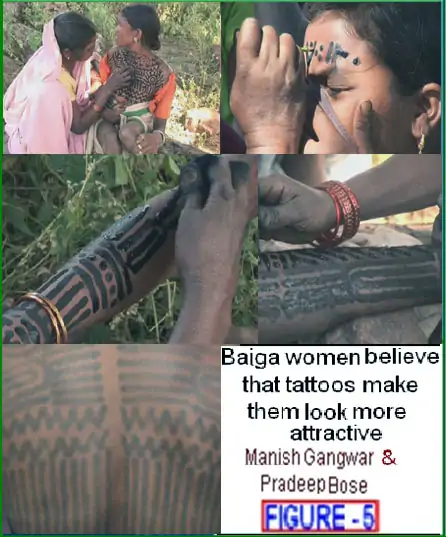
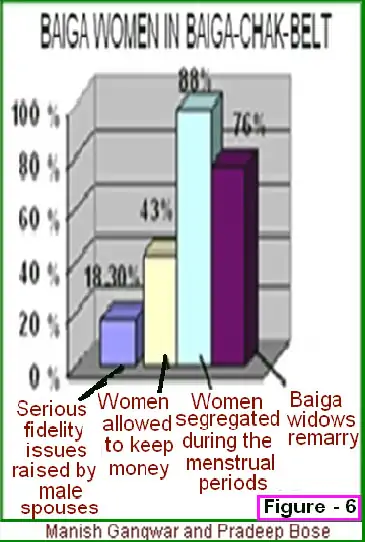
Since mid-2011 all the Baiga indigenous households in the BCB have been proud owners of land deeds.
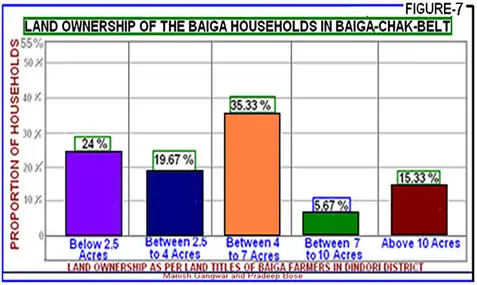
As per Figure 7 seventy nine percent of the BCB households got land deeds that made them owners of as little as 2 acres and many got between 4 to 7 acres of land. These 79 percent of respondents were not very happy, as they all expected to get at least land deeds for 7.5 acres for each Baiga household, yet they were relieved that they could no longer be served with any kind of eviction order and nor would they be subjected to repeated harassment by the forest department officials, as they themselves were the owners of the land and were not encroachers or land grabbers any more.
However 45 Baiga households from the control villages were unfortunate that they did not as yet get land deeds to the land area that they have tilled for hundreds of years. Moreover as the narration at the lower extreme margins show in Figure 8, only 48.9 percent of the control households had encroached forest land in their possession, which they cultivated, and more than 51 percent of them did not hold any land.
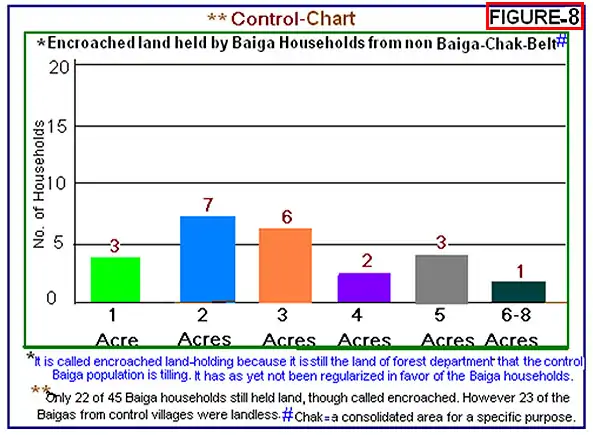
The following three tables present the food intake and food types consumed by the Baigas of BCB.
| Household Number | Breakfast | Lunch | Dinner |
|---|---|---|---|
| 1 | Pej + Bhaji | Pej + Bhaji | Dal + Rice |
| 2 | Dal + Rice + Greens + Veg. + Chapatis | Pej + Bhaji | Dal + Rice + Greens + Veg. |
| 3 | Pej + Bhaji + Dal + Rice + Chapatis | Pej + Bhaji | Dal + Rice + Greens + Veg. |
| 4 | Pej + Bhaji | Pej + Bhaji | Dal + Rice |
| 5 | Dal + Rice + Maize + Charota Bhaji | Pej + Bhaji + Kutki | Dal + Rice + Veg. |
| 6 | Pej + Bhaji + Maize + Charota Bhaji | Pej + Bhaji | Pej + Bhaji + Kodo + Charota |
| 7 | Pej + Bhaji + Dal + Rice + Greens + Veg. + Chapati | Pej + Bhaji | Dal + Rice + Greens + Veg. |
| 8 | Dal + Rice + Chapatis + Greens + Veg. | Pej + Bhaji | Dal + Rice + Greens + Veg. |
| 9 | Pej + Bhaji + Dal + Rice + Greens + Chapati | Pej + Bhaji | Dal + Rice + Greens + Veg. |
| 10 | Dal + Rice + Greens + Veg. | Pej + Bhaji | Dal + Rice + Greens + Veg. |
Table 4. Food Combinations Eaten by Baigas in Baiga-Chak.
Table 4 tells us the kinds of food combinations that the Baigas would eat during a day. Repetition of certain food items is the measure of their availability, as well as likability. We find that the Baigas are very fond of pej. Pej is an instant food of the Baigas. It is ground and roasted cereal, mostly kodo, kutki (small/minor millets) and sometimes maize, which is diluted with steaming water and it is boiled a bit and then eaten. Besides pej that occurs 17 times, bhaji (a leafy fried vegetable) is repeated 18 times, rice 12 times, greens 11 times, vegetables (brinjal, jack fruit, lady's finger, gourd etc.) 10 times, dal (cooked pulses) 13 times, wheat bread (chapattis) five times and also Charota Bhaji (Cassia tora) which is a very desirable food ingredient and can't be had daily, repeats itself 3 times.
| Foodstuff | Mean Daily Bharia Intake (#SD) | Mean Daily Baiga Intake (SD) | *NIN Standard |
|---|---|---|---|
| Cereals | 546 (11.6) | 478.8 (197.9) | 460 |
| Pulses | 50 (4.71) | 29.9 (44.9) | 40 |
| Green Leafy Vegetables | 30.8 (43.8) | 109.6 (18.6) | 40 |
| Other Vegetables | 33 (4.51) | 51.1 (7.5) | 60 |
| Roots and Tubers | 14.3 (34.7) | 13.6 (1.9) | 50 |
| Oils and Fats | 2.1 (3.7) | 2.0 (0.7) | 40 |
Table 5. Comparison of Mean Intake of Foodstuffs between the Bharia and Baiga Tribes of M.P. #SD stands for Standard Deviation, *NIN stands for National Institute of Nutrition. (Source: Chakma, Meshram, Rao, Singh and Kavishwar (2009).)
Table 5 indicates that Baigas do not eat enough pulses, roots and tubers and oils and fats, when these are compared to the standards set by the National Institute of Nutrition. When Baigas' mean intake of food items in terms of cereals, pulses and green leafy vegetables etc. is compared with those of the Bharia tribe (also an endangered tribe about 26,000 of whom live in the grand canyon in Patalkot and in its vicinity, located in the Chhindwara district of M.P.), the Bharias show significantly better intake for cereals and pulses and a marginally higher level of roots and tubers intake. But Baigas score significantly better than Bharias when they are compared for the intake of green leafy vegetables and other vegetables. In terms of intake of fats and oils both tribes score miserably.
| Nutrient | Mean Daily Baiga Intake (#SD) (N=475) | *NIN Standard |
|---|---|---|
| Meat and Eggs | 1.8 (17) | 40 |
| Milk and Milk Byproducts | 5.6 (30.1) | 150 |
| Energy (kcal) | 1818.6 (748) | 2425 |
| Protein | 51.5 (22.2) | 60 |
| Calcium (mg) | 447.5 (582) | 400 |
| Iron (mg) | 16.7 (13) | 28 |
| Vitamin A (μg) | 379.2 (867) | 2400 |
| Vitamin B-1 (mg) | 1.2 (0.6) | 1.2 |
| Vitamin B-2 (mg) | 0.5 (0.4) | 1.4 |
| Vitamin C (mg) | 18.8 (36) | 40 |
Table 6. Mean Daily Intake of Nutrients by a Baiga. #SD stands for Standard Deviation, *NIN stands for National Institute of Nutrition. (Source: Ibid.)
Table 6 shows that there is quite a variatiion in Baigas' levels of daily intake for energy, protein, meat and eggs, milk and milk byproducts, calcium, iron, vitamin A and vitamin C. But Baigas took almost consistently the same amount of vitamins B-1 and B-2, which were also much lower than the recommended levels. It may be stressed here that only fifty percent of the Baigas are able to eat three times a day. The remaining half of them manage to eat just two meals a day.
Figure 9 profiles 12 livelihoods that are practiced by the residents of the BCB. Livestock rearing is the ubiquitous livelihood of the Baigas of the BCB; there is not a single household that does not rear livestock. The second most popular livelihood after livestock rearing is agriculture. 90.67 percent of households in the BCB are engaged in agriculture. Hunting and fishing is the third most popular livelihood that is adopted by 82 percent of the BCB's households. The fourth ranked livelihood is that of wage labor. Forest produce gathering, followed by country liquor distillation and vending are the fifth and sixth ranked livelihoods respectively. The Baigas have been very reluctant to admit that they ever get engaged in the sixth-ranked livelihood of liquor distillation and vending. Mahua-flower based liquor distillation is an illegitimate activity if the Baigas distilled it for vending and not for self-consumption. Hence there may be more than 12.33 percent of Baiga households in the BCB who were actually engaged in the liquor related livelihood. Even though 16 percent of the respondents knew how to weave baskets only 3.67 percent of them were engaged in actual bamboo related works. [(There are five weekly haat villages in the BCB. But only three, i.e. of Cha(n)da, Kanhari and Paundi are popular. Barter (called vastu-vinimai) items that the Baigas exchange are the 22 products, given in Table 11, gathered as the forest produce, of which dried mahua flowers and kernels, harra and aonla are the most popular. Local shanties or haats offer Baigas about 80 percent of the market rates for these items.)] 52 persons from 300 households migrated between 2-3 months for wage earning in the previous year. 274 persons from 300 households were smokers. 138 women had control over the family's income expenditure. 79 Baiga widows remarried in last three years and there were 38 cases of spouses' conflicts owing to serious fidelity issues.)

Besides these major livelihoods there are six remaining livelihoods, viz. those of migration based wage earning, ethnic healing and sorcery, share-cropping, bamboo-works, wood and iron works and employment with GOs and NGOs which could be called marginal livelihoods of Baigas. Livestock population was distributed as follows: 166 cows, 13 buffaloes, 247 bullocks, 93 goats, 82 pigs and 217 poultry birds. Between April 2010 and March 2011 the respondents bought 13 cows, 4 two-year-old male calves, 82 bullocks, four goats, two pigs and seven poultry birds.
161 of 300 respondent households had silver ornaments and none had gold ornaments. The total amount of silver was 54.5 Kg. Hence the average silver ornaments per household came to about 192 gm. and the average silver ornament ownership among the ornament-possessing Baiga households was 338.5 gm.
None of the households studied had access to electricity.
All the agricultural practices are pursued by the BCB Baigas with great zeal. Nonetheless it is true that many septuagenarian Baigas were still nostalgic about their great days of Bewar. Even though these Baigas abandoned Bewar cultivation about 55 years ago and have taken up peasant or modern-way of agriculture, these older ones still rued the fact that the "foxy whites" made them give up Bewar. What they boasted about Bewar was that it gave them opportunity to grow and harvest 12 to 14 food crops, 18 types of vegetables, 21 types of leafy crops, and more than 20 types of grasses for their own and their livestock's consumption and besides they had seeds for the next crop; whereas, the new method of crop production helped them grow not even half the number of crops that they grew from the Bewar-way. BCB Baigas also complained that their yield from the new method of cultivation was not only lower in volume but was also full of hassles, because of the diseases and parasites that attacked their mono-crops.
About 65 percent of 1,850 acres, the total land area held by 300 Baiga households of BCB, is cultivated in the rainy season; whereas only 38 percent of the total land area is cultivated during the winter season, owing to paucity of irrigation.
These days Baigas grow about ten crops. Five of these are monsoon fed or Kharif crops and five crops are grown in the winter season. The Kharif crops that are produced by Baigas in the rainy season/summer (between June and September) are small/minor millets, viz. kodo (Paspalum scrobiculatum) and kutki (Picrorhiza kurroa), niger (edible oil), paddy and maize. Kutki is the most popular and abundantly grown crop of the Baigas because it is also their staple diet. The winter or rabi crops that are grown by Baigas are wheat, gram, rape seeds, lin seeds and peas. One special crop of the Baigas that is becoming popular among the non-tribals of Dindori district is Baiga-tur or their pigeon pea variety, owing to its great taste. The following two tables present the crop-wise area covered in the target villages.
The cereal crops of kutki, kodo, wheat, corn/maize were the top crops of Baiga-Chak, along with the chick pea (gram). These five crops accounted for a little over 85 percent of the total Baiga-owned cropped area of Baiga-Chak. The most depressing thing about Baigas' agriculture is that they are able to achieve only abysmally low levels of productivity. At least two ancient Baiga beliefs come in their way of augmenting agricultural production. These are: (a) plowing is akin to lacerating the breasts of their mother earth, hence many Baigas hesitate to plow their fields and just broad-cast seeds on the unprepared land; (b) putting inputs like manure is considered by the Baigas as akin to poisoning their mother earth, hence they prefer not to apply any other inputs but seeds, which limits their agricultural produce.
| Name of Crop | Area in Acres | Average Yield per Acre |
|---|---|---|
| Kodo | 250 | 125 kg |
| Kutki | 700 | 115 kg |
| Niger | 80 | 75 kg |
| Paddy | 75 | 3.5 qt |
| Maize | 125 | 3 qt |
Table 7. Kharif (Summer) Crops Grown by Baigas.
Since abandoning shifting cultivation altogether in the1960s, even though it is the third generation of Baigas that is engaged in agriculture, their skill in agriculture is so low that the per-acre yields received for all crops vis-a-vis non-Baigas is between one half and one third. For example, Baigas are able to get 3.5 quintals of paddy per acre and non-Baigas produce a yield of about 12 quintals of paddy per acre. The performance of kodo and kutki, Baigas' major cereal crops is as low as 1.15 to 1.25 quintals per acre whereas a non-tribal is likely to get yields of 4 quintals of kodo and kutki per acre.
Table 7 has kutki at the top followed by kodo, both being the small or minor millets. Then come the maize, niger and paddy. We find that Baigas grow niger as their favorite oil-seeds. However it is the mahua (Madhuca indica) kernels that the Baigas prefer to use as their source of oil.
Table 8 shows that Baigas grew in descending order of area sown, gram, wheat, rape seeds, linseed oils and peas.
Besides, Baigas also use mahua (Madhuca indica) kernels as their source of edible oil.
| Name of Crop | Area in Acres | Average Yield per Acre |
|---|---|---|
| Wheat | 144 | 3 qt |
| Gram | 430 | 2.5 qt |
| Rape Seed | 64 | 2.2 qt |
| Lin Seed | 44 | 1.2 qt |
| Peas | 25 | 80 kg |
Table 8. Rabi (Winter) Crops Grown by Baigas.
Baigas grow cereals on about 64.22 percent of their total area. Therefore they are hardly left any spare land to grow any other crop in considerable areas other than gram or chick peas. Nonetheless agriculture is a satisfying livelihood for the Baigas because about 66 percent of Baiga households from the sample are able to grow enough cereals to meet their annual requirements. Besides the aforementioned crops, lentils, potatoes and vegetables are also grown by the Baigas. However the total area under these crops is only sixteen acres. Similarly, Baigas have started growing some fruit trees, like those of hybrid mangoes, guavas, papayas, jack fruit etc.
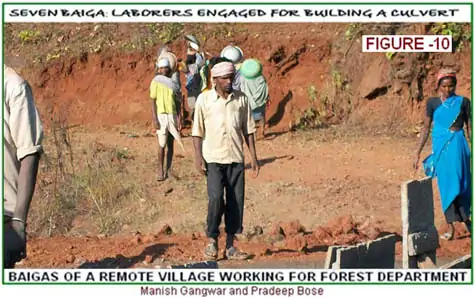
The Baigas from the BCB earned their wage labor based livelihood through three activities. These were: as agricultural laborers, NREGA laborers and as forest department's casual wage laborers. A significant number of people, who make up around 60 percent of the total population, are engaged in wage earning. As the data of Table 9 depicts, though there were 176 of the total 321 households engaged in wage earning, yet, in all, 385 total family members were earning from the livelihood of wage labor. Similarly, though only 77 of 321 households studied were engaged in forest produce gathering, in fact 244 members of 77 households were gathering forest produce. The third livelihood of brick laying (Baigas do not use fired bricks) was adopted by only 68 of 321 households studied. But actually 156 members were engaged in brick laying. Here it should be noted that brick laying has not been used as a commercial activity by the Baigas. Those households that are not engaged in brick laying make a partial payment for the unfired bricks through barter or kind, which is mutually decided upon volume of an agricultural commodity or forest produce.
| Livelihood | Households | Heads of *Hoho | Spouses | Sons | Daughters | Total |
|---|---|---|---|---|---|---|
| Wage Labor | 176 | 165 | 109 | 68 | 43 | 385 |
| Forest Produce Gathering | 77 | 67 | 62 | 21 | 17 | 244 |
| Brick Laying | 68 | 32 | 30 | 15 | 11 | 156 |
Table 9. Family Member Contributions Made to Livelihoods. *Hoho = Household.
Besides, game hunting is also practiced as a non-commercial activity and it is pursued to replenish animal protein requirements or for claiming traditional jungle-meat by the hunters and their family members.
The share of six major livelihoods of the Baigas is presented in Table 10. Agriculture is the leading livelihood that contributes 31.5 percent of the total annual income. Wage earning through NREGA (National Rural Employment Guarantee Act for providing 100 days worth of employment to rural poor each year) plus the casual work offered by the Forest Department accounted for 25.5 percent of the total income and they earned additional amounts as agricultural laborers that equaled about 9 percent of total income. By merging the preceding two livelihoods based on labor one may claim that wage labor is the top earning livelihood of the Baigas in the BCB.
| Livelihood | Share of the Livelihood in *hoho Income |
|---|---|
| Agriculture | 31.5% |
| Wage earning from NREGA and forest department | 25.5% |
| Wage Earning as Agricultural Laborers | 9% |
| Liquor Distillation and Vending | 7.4% |
| Forest Produce Gathering | 6.8% |
| Animal Husbandry | 4.4% |
Table 10. Livelihood Contribution to Households' Income at Current Prices. *Hoho = Household.
There are four major items under forest produce gathering that figure prominently in the BCB. These are tendu leaves (Diaspyros melanoxion) (its tender leaves are used for making a local variety of cigarettes called beedis), safed musli, seeds of chironji (Buchania lanzan) (the kernels are used as dry fruit) and guggal (it is the resin of a shrub (Commiphora mukul), and is used as a low quality burning essence and ingredient of an Ayurvedic medicine, made for reducing obesity). About 85 percent of 77 target households' forest-based income could be attributed to these four items. Table 11 lists other forest products that the Baigas gather and market in weekly shanties.
| Common Name of Herb/Plant | Botanical Name of Herb/Plant |
|---|---|
| Aonla | Emblica officinalis |
| Ashwagandha | Withania somnifera |
| Bel/Bilva | Aegle marmelos |
| Baheda | Terminalia bellirica |
| Mahua | Madhuca longifolia |
| Dhawal | Woodfordia fruticosa |
| Kalmegh | Andrographis paniculata |
| Chirota | Cassia tora |
| Harra | Terminalia chebula |
| Kareel | Bambusa arundinacea |
| Nagarmotha | Cyperus scariosus |
| Wild Honey | |
| Satavar | Asparagus racemosus |
| Safed Musli | Chlorophytum/Borivillianum |
| Kali Musli | Curuligo orchioides |
| Anantmul | Tylophora indica |
| Lemon grass/Gandha-Trina | Cymbopogan flexuosus/Cymbopogan citratus |
| Van Tulsi | Ocimum virdi/Ocimum gratisimum |
| Vividang | Embelia ribes |
| Bark of Arjun | Terminalia arjuna |
| Gudmar | Gymnema sylvestre |
| Kalihari, Langli | Gloriosa superba |
| Bhilma | Semecarpus anacardium |
Table 11. Forest Produce Gathering by Baigas.
It is necessary to point out here that the data collection on liquor distillation and vending was done twice. The first time we interviewed the respondents only 2 percent of them agreed to have ever distilled liquor and vended it. However, we collected the same data a second time after we had spent more than six months in the BCB and had seen many Baigas distilling liquor and also a few instances of vending. We had a focus group discussion on the topic of liquor distillation and vending with two contact persons who were natives and helped us to courier and acted as guides and three other local Baigas who worked as NGO or GO staff members. At the end of that discussion, it became apparent that about 45 percent of native Baigas from Baiga-Chak were engaged in the clandestine livelihood of bootleggers, but most of the practitioners of the trade were reluctant to formally answer our related questions. Hence, we decided to include only that data on record (12.33 percent of households that accounted for 7.4 percent of 300 Baiga households' total income).
Over and above the six major aforementioned livelihoods of the Baigas in Baiga-Chak, there are a dozen more minor livelihoods. Of these lower order livelihoods six are listed, along with each livelihood's share of income, in Table 12.
| Livelihood | Households Adopting the Livelihood | Contribution to Income |
|---|---|---|
| Bamboo Work | 44 | 4.1% |
| Sorcerers, Gunias and Shamans | 25 | 2.4% |
| Shopkeepers | 12 | 2.8% |
| Blacksmiths and Carpenters | 10 | 2.7% |
| Firewood Sale | 17 | 1.3% |
| Government and NGO Employment | 4 | 0.8% |
Table 12. Some Lower Order Livelihoods of the Baigas.
Only a couple of very minor livelihoods remain. These involve two Baigas in vending vegetables and another two running cycle repair shops.
Of the 5,000 or so Baiga households that lived in the BCB originally few have lived there consistently or consecutively (see Appendix 2). Appendix 1 gives the list of Baiga-Chak villages along with the number of Baiga households and total Baiga population in each of these BCB villages for the census years 1971 and 2001, which suggests that Baigas are not yet fully settled in the BCB. The reason for the Baigas' transitory pattern, though now restricted to only 30 percent ephemeral population and once in a decade whole-hog shifting, is that they are still eking out a subsistence-based living. As soon as there are major disasters in the BCB, like drought, famine or floods, these poorest Baigas, living on the edge, migrate to greener pastures. Figure 11 gives three livelihood fits that are available to Baiga households. Each livelihood fit has at least one stable livelihood and two to four supplementary livelihoods. Baigas are constantly trading off between these three livelihood fits and, as and when they find that their dynamic set of livelihoods would not help them tide over the ensuing disaster, they migrate to alternate sites of living, recoup for about 3-4 years and then again return to the BCB.
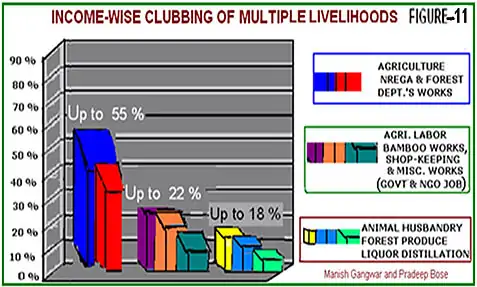
Baigas do not like borrowing. About 35 percent of 522 Baiga debtors in Baiga-Chak have cleared their dues in the last year after they got their land deeds and as women's self help groups in their villages saved enough cash to repay the outstanding loans. In most cases it is the traders collecting agricultural produce from the fields and homes of the Baigas, who tempt Baigas to borrow from them. Most of these traders belong to the erstwhile oil extracting caste of 'oilies' (called telis or sahus colloquially). There were some traders from traditional usurers' caste of Bania too that traded with the Baigas. The telis from Paundi village and Baijag Kasbah lent money to the needy Baiga households, generally in kind, as cereals and pulses from their own shops and charged interest of 48 percent per annum from the Baigas. None of the Baigas ever borrowed amounts in excess of Rs. 2,000 per transaction from the traders. In all 339 members from 243 households were found indebted. The average amount per indebted Baiga household was Rs. 2,212.
Only one aspect of the Baiga respondents from the control group, i.e. their status of land holding, has been presented under the subsection Land Ownership And Agriculture above. We studied a sample of 217 Baigas from 45 Baiga households, 15 households chosen randomly from four villages, viz. Mungela, Sidhouli, Chandragarh and Surajpur, as detailed in Table 3 in the section Research Methodology.
One key difference between the Baiga-Chak villages and non-Baiga-Chak villages was that only in the BCB each of the Baiga-inhabited villages had its own elected Muqaddam or Samarth — a community-judge who sorted out differences between Baigas if any arose — and a selected Kotwal or a community lobbyist, who gathered Baigas for meetings and who did the bidding for the Muqaddam. None of the four non-Baiga-Chak villages had these Baiga community level officials. Since Muqaddam and Kotwal are Persian words it seems that these offices were created during the Mughal rule of India in medieval times who used Persian as the court language.
There were two obvious livelihood based differences between the Baigas of the BCB and the Baigas of the control group. (A) Each Baiga household in the BCB had access to at least four and in most cases five livelihoods in a year whereas about half of the Baiga households from the control group had access to just two livelihoods and half of them could practice three livelihoods in a year. Hence BCB Baigas had, on average, two more livelihood options available to them than those of the control Baiga group. (B) As stated earlier, none of the control households, even though 22 of the 45 households had been tilling their pieces of land for more than 100 years, was given the land deeds and hence were deemed encroachers of government forest land.
We found that against the Baiga-Chak's 17 persons from 300 households migrating for earning their livelihoods, who constituted merely 5.67 percent, there were 15 Baiga persons from the control group of 45 households who migrated, constituting 33.3 percent of the total. Another significant difference between the Baiga households from within the BCB and without was that only 14 households of 300 households from the former group that comprised just 4.67 percent of households from the total were engaged as share croppers and the figure for the same activity for the latter group was 33 out of 45, or slightly above 75 percent control Baiga households were engaged in share cropping. Another significant variation between the control and BCB Baigas was that in the case of the former group, though there were marginally fewer households (18 of the total 45 households or 40 percent for control, as against the BCB group's slightly above 47 percent households), engaged in forest produce gathering the share of income of the control group from forest produce gathering was 17.5 percent compared to a share of 6.8 percent in the BCB.
Photography and text © 2012, Manish Gangwar and Pradeep Bose. All rights reserved.
Gangwar, M., and Bose, P. (2012), "A Sociological Study of the Livelihoods of the Baigas in Baiga-Chak Belt of Dindori, India." The Peoples of the World Foundation. Retrieved
December 27, 2025,
from The Peoples of the World Foundation.
<https://www.peoplesoftheworld.org/hosted/baigas/>

